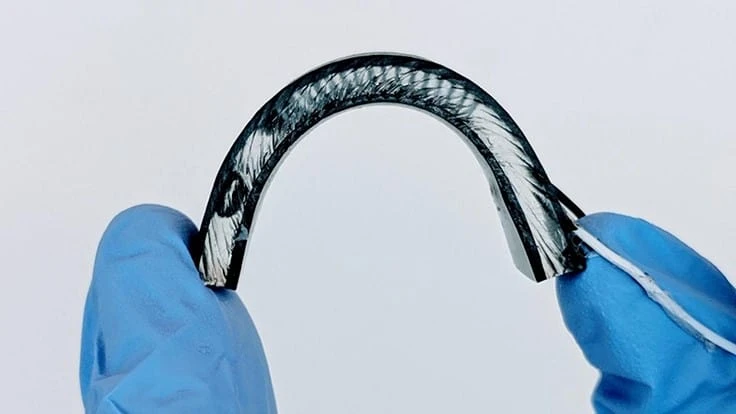
Photo courtesy of Mehmet Ozturk, NC State University.
Engineers from North Carolina State University have demonstrated a flexible device that harvests the heat energy from the body to monitor health. The device surpasses all other flexible harvesters that use body heat as the sole energy source. The NC State researchers report significant enhancements to the flexible body heat harvester they first reported in 2017 (which we covered on Today’s Medical Developments website).
The harvesters use body heat energy to power wearable technologies – think of smart watches that measure your heart rate, blood oxygen, glucose, and other health parameters – that never need to have their batteries recharged. The technology relies on the same principles governing rigid thermoelectric harvesters that convert heat to electrical energy.
Flexible harvesters that conform to the human body are highly desired for use with wearable technologies. Mehmet Ozturk, an NC State professor of electrical and computer engineering and corresponding author a paper published in Applied Energy, mentions superior skin contact with flexible devices, as well as the ergonomic and comfort considerations to the device wearer, as the core reasons behind building flexible thermoelectric generators (TEGs).
The performance and efficiency of flexible harvesters, however, currently trail well behind rigid devices, which have been superior in their ability to convert body heat into usable energy.
"The flexible device reported in this paper is significantly better than other flexible devices reported to date and is approaching the efficiency of rigid devices, which is very encouraging," Ozturk says.
The proof-of-concept TEG originally reported in 2017 employed semiconductor elements that were connected electrically in series using liquid-metal interconnects made of EGaIn – a non-toxic alloy of gallium and indium. EGaIn provided both metal-like electrical conductivity and stretchability. The entire device was embedded in a stretchable silicone elastomer.
The upgraded device employs the same architecture but significantly improves the thermal engineering of the previous version, while increasing the density of the semiconductor elements responsible for converting heat into electricity. One of the improvements is an improved silicone elastomer that encapsulates the EGaIn interconnects.
"The key here is using a high thermal conductivity silicone elastomer doped with graphene flakes and EGaIn," Ozturk says.
The elastomer provides mechanical robustness against punctures while improving the device's performance.
"Using this elastomer allowed us to boost the thermal conductivity – the rate of heat transfer – by six times, allowing improved lateral heat spreading," he notes.
Ozturk adds that one of the strengths of the technology is that it eliminates the need for device manufacturers to develop new flexible, thermoelectric materials because it incorporates the very same semiconductor elements used in rigid devices. Ozturk says future work will focus on further improving the efficiencies of these flexible devices.
Yasaman Sargolzaeiaval, Viswanath P. Ramesh, Taylor V. Neumann, Veena Misra, Michael Dickey and Daryoosh Vashaee co-authored the paper. The group also has a recent patent on the technology.
Latest from Today's Medical Developments
- IMTS 2026 runs Sept. 14-19 at McCormick Place in Chicago, Illinois
- Master Bond’s MasterSil 800Med
- ZEISS celebrates 100 years of advancing innovation in the US
- Teleflex sells acute care and urology businesses for $2.03 billion
- HANNOVER MESSE: Where research and manufacturing meet
- What’s next for the design and manufacturing industry in 2026?
- Arcline to sell Medical Manufacturing Technologies to Perimeter Solutions
- Decline in German machine tool orders bottoming out





